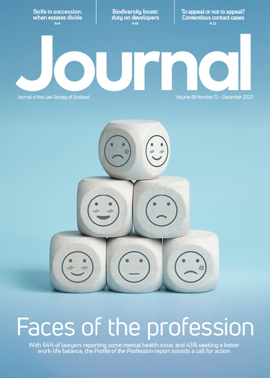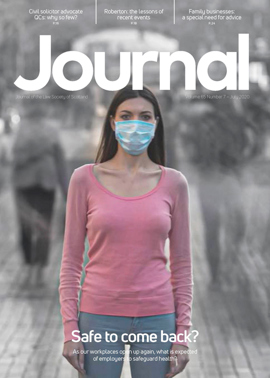The silk road: a modern journey

Just over two decades ago I wrote an article (Journal, April 2000, 22) that I intended to afford some guidance to those considering qualifying as a solicitor advocate, as I had just been introduced as one myself. It is fair to say that things have changed a little over the last 20 years, and I thought it might be time to offer aspiring solicitor advocates the benefit of my experience gained during my journey to taking silk, as well as looking ahead to the changes we might expect to be coming our way.
It surprises some that the criteria for being awarded the rank and dignity of senior counsel are the same for solicitor advocates and advocates. One is assessed on one’s ability to present highly complex and challenging cases in the supreme courts of Scotland. The full guidance on the criteria can be found on www.scotland-judiciary.org.uk
In 2000 the Scottish Government published a research paper which recorded that in 1996 there were 87 solicitor advocates. Today the Law Society of Scotland’s website indicates that there are now 201 civil and 152 criminal solicitor advocates. There remain approximately 460 practising members of the Faculty of Advocates, of whom approximately one fifth are Queen’s Counsel. One might conclude that there has been significant progress in expanding consumer choice as to who they instruct to conduct advocacy. Yet only six solicitors have taken silk as civil solicitor advocates. Why is that?
Out of court
One of the reasons probably lies in practical difficulties surrounding the practice of civil advocacy as a solicitor. Historically, it has been difficult for solicitors carrying their solicitor work to find the time to appear in proofs and procedure rolls. This is one of the reasons that Brodies LLP founded an in-house set of dedicated solicitor advocates called Advocacy by Brodies. We want to retain talent by facilitating those who want to develop a career focused on advocacy to do that at the firm.
Another reason why there are fewer civil silks on the solicitor side of the profession may be the reduced opportunities to appear in court. It is fair to say that when I started conducting advocacy in the 1990s there was significantly more appearance work than there is now. Indeed, in the early 1990s almost every aspect of a court action required to take place before judge. An example was “tabling”, whereby any ordinary cause sheriff court action called before a sheriff to “table”, a pointless hearing at which nothing happened other than that the defended case was noted as having “tabled”. Successive changes in procedure have seen less and less day-to-day oral civil advocacy happening. The packed courts and the lengthy motion rolls of old in the Outer House had been a source of experience for many members of the junior bar as well as a valuable source of income. Today, many litigators find it difficult to get time on their feet in a civil court at all.
Getting the breaks
Having gained significant experience in the sheriff courts, qualified as a solicitor advocate and run my first Court of Session proof, I was fortunate to move to a large insurance firm where my path to seeking silk became clear. Also, the introduction of personal injury procedure in the Court of Session led to an upswing in interlocutory appearance work while everyone began to get used to how the rules should work. At the same time, I was able to expand my commercial practice as well as acting in many professional negligence and construction disputes.
It is fair to say that the impact of Faculty’s prohibition on “mixed doubles” had an unexpectedly positive impact on my route to taking silk. The rule prohibited members of Faculty from appearing with solicitor advocates. The term “mixed doubles” came about because the then Dean introduced the rule during the Wimbledon fortnight. The fact that it was not possible for clients to instruct a senior with whom I could appear resulted in many clients choosing to continue instructing me alone. This meant that I was privileged to conduct some interesting and complicated cases, usually against junior and senior counsel, myself. Had clients been afforded the opportunity to instruct “mixed doubles”, I am not sure that I would have been favoured with the opportunity of conducting so many cases on my own. However, I was very pleased when the rule was revoked and I had the opportunity to work with a number of silks.
If the solicitor branch of the profession wishes to retain its advocacy talent, then it must offer sufficient opportunities to conduct advocacy. Which is why, at Brodies, we aim to afford those of our solicitors who want to qualify as solicitor advocates the opportunity to be trained and appropriately experienced to do so. That means good quality training and time on their feet. Similarly, our dedicated set of solicitor advocates is there to provide a choice to our clients, as well as a secure platform from which solicitor advocates can build and conduct their advocacy careers.
Dispute resolution today
In the last few decades, we have seen new tribunals, adjudication, arbitration and mediations, and this has led to a significant decline in the amount of traditional civil litigation being conducted in Scotland as well as a rise in solicitors specialising in particular types of dispute resolution. I see the future of advocacy being the same – solicitor advocates will become more specialist, and to do that they will need to be in larger firms with specialist or niche practices.
It is also fair to say that COVID-19 has changed and will continue to change dispute resolution. However, we should look at that as an opportunity because as lawyers we have a rare opportunity to determine the direction of travel.
The pandemic has lent much force to Professor Susskind’s assertion in his most recent book, Online Courts and the Future of Justice, that the courts should be a service and not a place. As the author observes, many people cannot afford to use our excellent but complex courts.
If we embrace the opportunities for change, we ought to be able to afford greater access to justice and reduce the costs associated with resolving disputes.
Clients’ changing demands
But what does the future hold for those with higher rights of audience? We too ought to embrace the opportunities. Advocacy by Brodies aims to be able to operate with clients and colleagues in a more flexible and integrated way, using information technology.
It seems to me that the future of Scottish dispute resolution must lie in adopting more flexible ways of working and maximising the benefits of technology, thereby reducing costs and affording consumers greater access to justice.
The focus for our profession ought to be how we can use the new skills and techniques we have learned during this pandemic to better deliver the resolutions that our clients want. In that endeavour we must not be dogmatic in defending the historic way, or ways, in which our profession has chosen to try and resolve disputes. Anyone who has teenagers will know that they socialise and communicate differently. Often, they prefer meeting online to going out to meet friends. The lawyers of the future will see nothing strange in resolving disputes online; indeed they will probably look on tales of “motion rolls” in the way we did about our grandparents speaking about gas lighting and their first crystal radio set.
If clients, particularly in civil disputes, want and need online dispute resolution, whether such resolution involves oral online hearings or not, that is something that our system requires to deliver. The fact that we have considerable numbers of our profession, including me, who have devoted their careers to resolving disputes in a particular way is not a reason to refrain from delivering that. Those of us who grew up under these old systems may fear change but, in the midst of COVID-19 and the challenges that we all face as a result, I find myself remembering the words of Clint Eastwood as the drill instructor in Heartbreak Ridge – “improvise, adapt and overcome”. I suggest that, as ever, Scots lawyers will, and we shall!







